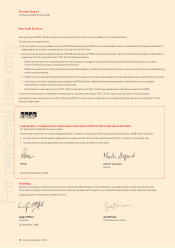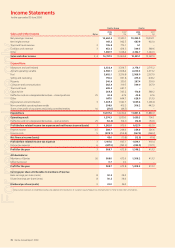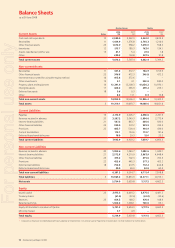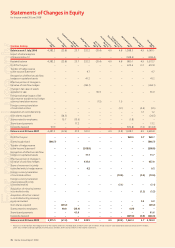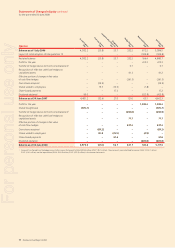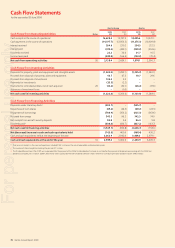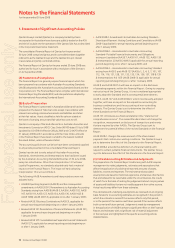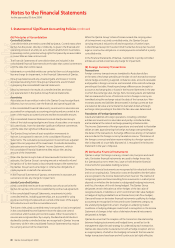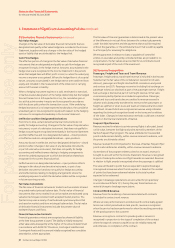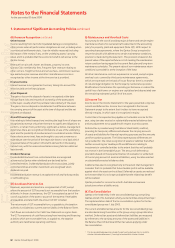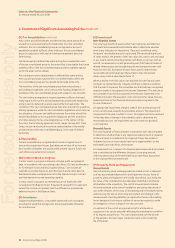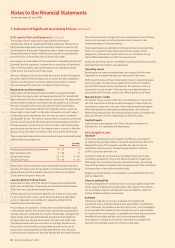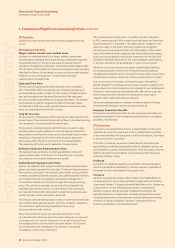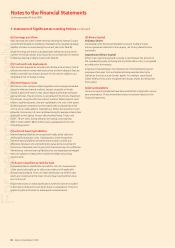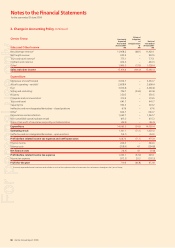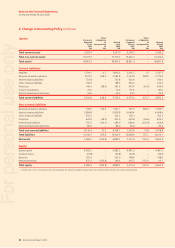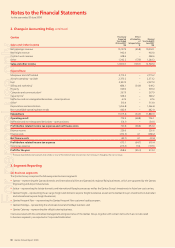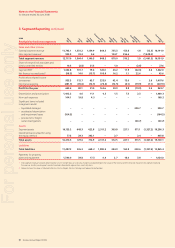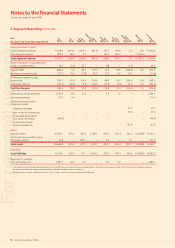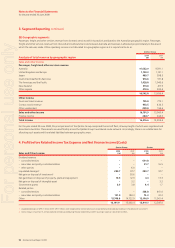Qantas 2008 Annual Report Download - page 85
Download and view the complete annual report
Please find page 85 of the 2008 Qantas annual report below. You can navigate through the pages in the report by either clicking on the pages listed below, or by using the keyword search tool below to find specific information within the annual report.
83 Qantas Annual Report 2008
(K) Tax Consolidation continued
Any current tax liabilities/assets and deferred tax assets arising from
unused tax losses assumed by the head entity from the controlled
entities in the tax consolidated group are recognised as amounts
payable/(receivable) to/(from) other entities in the tax consolidated
group in conjunction with any tax funding arrangement amounts
(refer below).
Qantas recognises deferred tax assets arising from unused tax losses
of the tax consolidated group to the extent that it is probable that future
taxable profi ts of the tax consolidated group will be available against
which the asset can be utilised.
Any subsequent period adjustments to deferred tax assets arising
from unused tax losses assumed from controlled entities within the
tax consolidated group are recognised by the head entity only.
The members of the tax consolidated group have entered into a
tax funding arrangement, which sets out the funding obligations of
members of the tax consolidated group with respect to tax amounts.
The tax funding arrangements require payments to/(from) the head
entity equal to the current tax liability/asset assumed by the head entity
and any tax loss deferred tax asset assumed by the head entity. The
members of the tax consolidated group have also entered into a valid tax
sharing agreement under the tax consolidation legislation which sets out
the allocation of income tax liabilities between the entities should the
head entity default on its tax payment obligations and the treatment
of entities leaving the tax consolidated group. In the opinion of the
Directors, the tax sharing agreement limits, subject to any ASIC Class
Order, the joint and several income tax related liability of the wholly-
owned entities of the tax consolidated group in the case of default
by Qantas.
(L) Receivables
Current receivables are recognised and carried at original invoice
amount less impairment losses. Bad debts are written off as incurred.
Non-current receivables are carried at the present value of future net
cash infl ows expected to be received.
(M) Contract Work in Progress
Contract work in progress is stated at cost plus profi t recognised to
date, in accordance with accounting policy Note 1(G), less an allowance
for foreseeable losses and less progress billings. Cost includes all
expenditure related directly to specifi c projects and an allocation of
fi xed and variable overheads incurred in the Qantas Group’s contract
activities based on normal operating capacity.
Contract work in progress is presented as part of trade and other
receivables in the Balance Sheet. If payments received from customers
exceed the income recognised, then the difference is presented as
deferred income in the Balance Sheet.
(N) Inventories
Engineering expendables, consumable stores and work in progress
are valued at weighted average cost, less any applicable allowance
for obsolescence.
(O) Impairment
Non-financial Assets
The carrying amounts of assets (other than inventories and deferred
tax assets) are reviewed at each balance date to determine whether
there is any indication of impairment. If any such conditions exists,
the assets’ recoverable amount is estimated. The recoverable amount
of other assets is the greater of their fair value, less costs to sell and value
in use. Assets which primarily generate cash fl ows as a group, such as
aircraft, are assessed on a cash generating unit (CGU) basis inclusive of
related infrastructure and intangible assets and compared to net cash
fl ows for the CGU. Estimated net cash fl ows used in determining
recoverable amounts have been discounted to their net present
value, using a rate as described in Note 17.
When a decline in the fair value of an available for sale fi nancial asset
has been recognised directly in equity and there is objective evidence
that the asset is impaired, the cumulative loss that had been recognised
directly in equity is recognised in the Income Statement. The amount of
the cumulative loss that is recognised in the Income Statement is the
difference between the acquisition cost and current fair value, less any
impairment loss on that fi nancial asset previously recognised in the
Income Statement.
An appropriate impairment charge is made if the carrying amount of
a non-current asset exceeds its recoverable amount. The impairment
is expensed in the year in which it occurs. An impairment loss is reversed
if there has been a change in the estimates used to determine the
recoverable amount. An impairment loss with respect to goodwill
is not reversed.
Financial Assets
The carrying value of fi nancial assets is assessed at each reporting date
to determine whether there is any objective evidence that it is impaired.
A fi nancial asset is considered to be impaired if objective evidence
indicates that one or more events have had a negative effect on the
estimated future cash fl ows of that asset.
An impairment loss in respect of a fi nancial asset measured at amortised
cost is calculated as the difference between its carrying amount,
and the present value of the estimated future cash fl ows discounted
at the original effective interest rate.
(P) Property, Plant and Equipment
Owned Assets
Items of property, plant and equipment are stated at cost or deemed
cost less accumulated depreciation and impairment losses. Items of
property, plant and equipment are initially recorded at cost, being the
fair value of the consideration provided plus incidental costs directly
attributable to the acquisition. The cost of acquired assets includes
the initial estimate at the time of installation and during the period of
use, when relevant, of the costs of dismantling and removing the items
and restoring the site on which they are located, and changes in the
measurement of existing liabilities recognised for these costs resulting
from changes in the timing or outfl ow of resources required to settle
the obligation or from changes in the discount rate.
An element of the cost of an acquired aircraft is attributed on
acquisition to its service potential refl ecting the maintenance condition
of its engines and airframe. This cost is depreciated over the shorter
of the period to the next major inspection event or the remaining
life of the asset.
Notes to the Financial Statements
for the year ended 30 June 2008
1. Statement of Significant Accounting Policies continued
For personal use only


